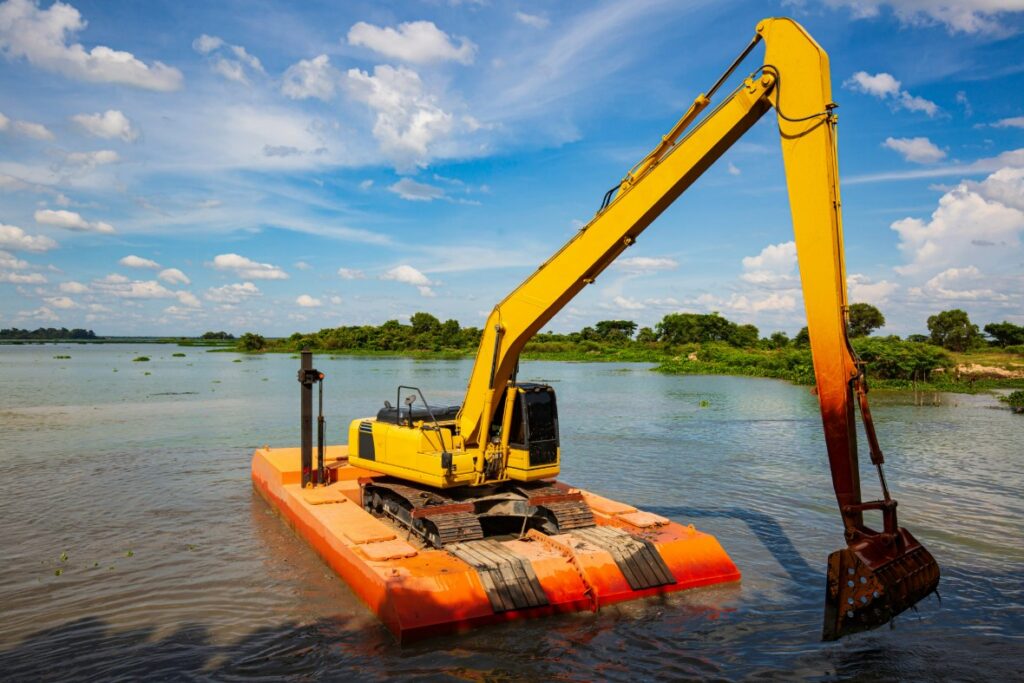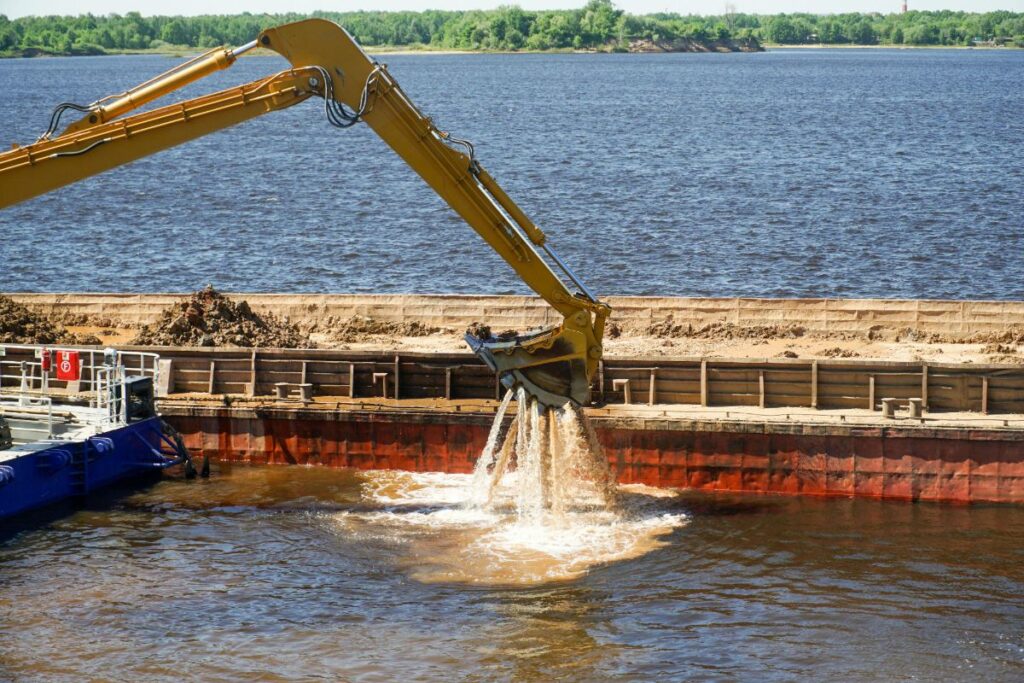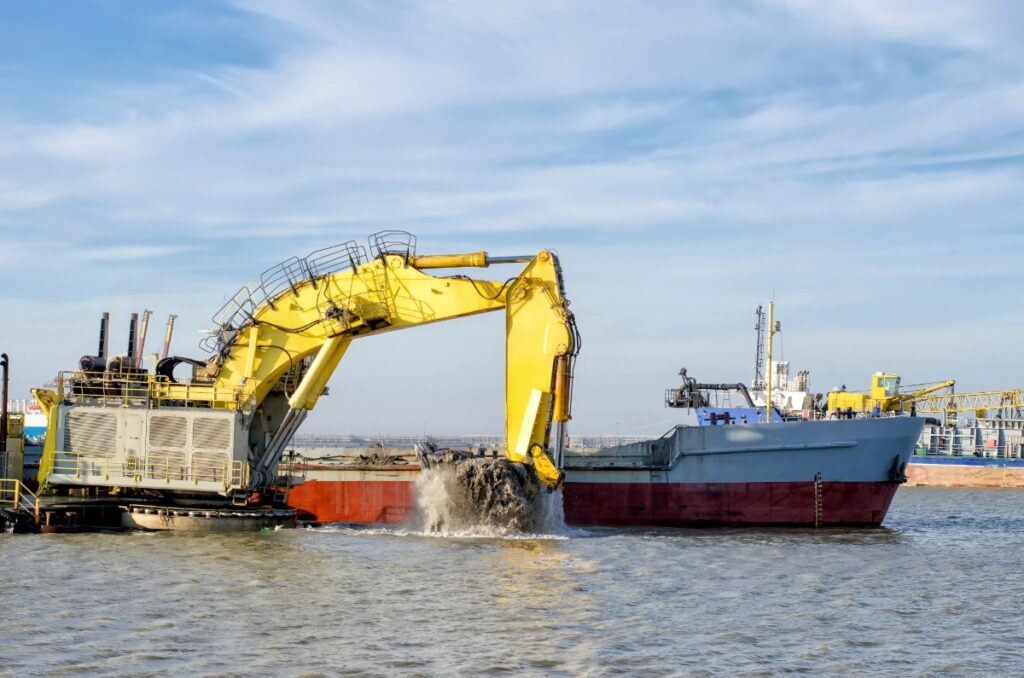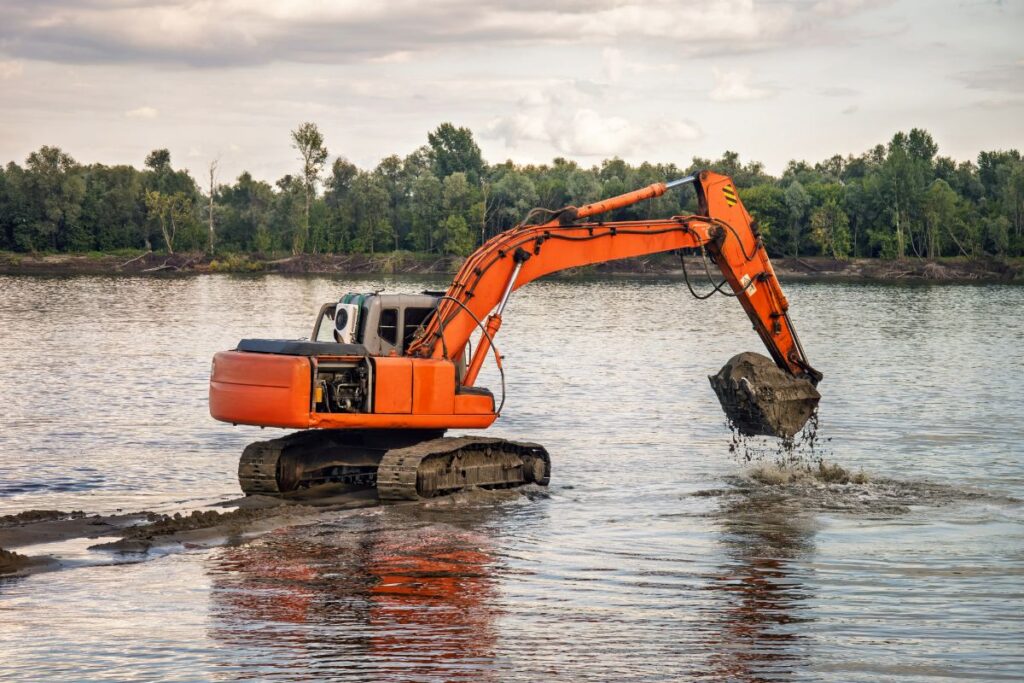Floating excavators are essential machines designed for specialized tasks in construction, mining, and environmental applications. These versatile excavators are capable of operating in difficult terrains, such as marshes, swamps, and shallow water bodies. Their unique amphibious design allows them to float on water and work efficiently where traditional excavators cannot function.
The importance of floating earthmovers lies in their ability to execute projects that require a combination of land and water capabilities. They are commonly used for dredging, flood control, wetland restoration, and other tasks in sensitive environments. These capabilities make floating excavators invaluable for industries like mining, oil, gas, and construction, where projects often involve challenging environments that demand specialized equipment.
For procurement heads, engineering managers, project contractors, and government buyers in sectors like mining, oil and gas, and heavy industries, floating dredgers offer a solution for improving productivity and reducing downtime. The ability to perform in environments where conventional machinery struggles is a significant advantage. This blog will explore the key features, benefits, and applications of floating earthmovers, with a focus on understanding their real-world value. It will also provide crucial information on the floating excavator price and options available for those interested in purchasing a floating dredger.
What is a Floating Excavator?
A floating earthmover is a specialized amphibious excavator designed to work both on land and in water. Unlike traditional excavators, floating dredgers are equipped with pontoons or other buoyant undercarriages that allow them to float on water. This design enables them to operate in environments like marshes, swamps, and shallow waters, where standard excavators would sink or be ineffective.
These machines are equipped with features that make them highly versatile for challenging projects. Key features include sealed pontoons, which provide flotation and stability, spud poles for anchoring and minimizing movement, and low ground pressure systems to ensure they can operate on soft, unstable ground without sinking.
Notable examples of floating earthmovers include the Waterking WK 95 and Waterking WK 150, which are both engineered to handle a range of dredging and excavation tasks in aquatic environments. Additionally, many manufacturers offer custom floating excavators for sale, allowing for the customization of pontoon sizes and machine configurations to meet specific project needs.
When considering purchasing a floating dredger, the floating excavator price is an important factor to take into account. The price can vary depending on the model, size, and custom features, which is why potential buyers often look for a floating excavator for sale that suits their budget and project requirements. Understanding the floating excavator price helps businesses make informed purchasing decisions, ensuring they select the best machine for their needs without overspending.
For businesses looking for a floating excavator for sale, options are available across a wide price range, ensuring there is a solution for both large-scale industrial projects and smaller, more specific tasks. With floating dredgers becoming increasingly popular for waterway maintenance and environmental restoration, understanding the cost of floating dredgers helps procurement teams better plan their budgets and project timelines.
Technical Structure of Floating Excavators

Floating earthmovers are specifically engineered for challenging terrains, such as marshes, swamps, and shallow waters. Their technical structure is built to optimize both land and water operations, combining the best aspects of traditional excavators with specialized features for aquatic environments. Below, we explore the key components of a floating earthmover and how they contribute to the machine’s performance and versatility.
Upper Structure (House)
The upper structure, or “house,” is the central part of the floating earthmover that sits atop the undercarriage. It houses crucial components that enable the machine to perform efficiently in both land and water-based environments.
- Rotating Platform for 360-Degree Movement
The rotating platform allows the upper structure to move freely, providing 360-degree movement for increased flexibility. This enables operators to position the boom and arm with precision, ensuring maximum productivity and efficiency during operations. - Operator’s Cab and Control Systems
The operator’s cab is designed for comfort and functionality, providing easy access to controls and advanced systems. It features intuitive controls, ergonomic seating, and often advanced displays to ensure precision when working in complex environments. These systems allow for smooth operation even under challenging conditions. - Engine, Hydraulic Components, and Counterweights
The engine and hydraulic systems are the heart of any floating excavator, providing the power needed for heavy lifting, digging, and dredging. The counterweights are strategically placed to ensure balance during operations, particularly when extending the boom or when performing heavy lifts in unstable or soft terrains. The combination of these components ensures the machine can operate with stability and efficiency.
Undercarriage and Pontoons
The undercarriage and pontoons are the critical components that distinguish floating earthmovers from traditional land-based models. These elements are specially designed to provide flotation and stability when working in water and on soft ground.
- Specialized Pontoons for Flotation and Stability
Floating excavators are equipped with large, sealed pontoons that enable the machine to float on water. These pontoons provide buoyancy and distribute the weight of the machine, allowing it to operate on water without sinking. The pontoons’ design is optimized to ensure maximum stability during operations in aquatic environments, making them ideal for dredging, waterway maintenance, and wetland restoration. - Track Systems Designed for Low Ground Pressure
The track systems of floating dredgers are designed to minimize ground pressure, allowing the machine to operate on soft, swampy, or marshy terrain without becoming bogged down. This makes floating dredgers ideal for areas where traditional equipment would struggle to maintain traction or stability. Low ground pressure systems ensure the machine can traverse these challenging environments while avoiding environmental damage. - Modular Pontoon Systems for Customization
Many floating excavators feature modular pontoon systems that can be customized based on project requirements. These systems allow for adjustments in flotation and stability depending on the water depth and specific task needs. Customizable pontoons offer flexibility, ensuring that floating earthmovers can be adapted to various operational environments.
Attachments and Versatility
The versatility of floating dredgers is a significant advantage in complex projects. These machines are designed to adapt to a wide range of tasks, from dredging and excavation to environmental restoration and flood control.
- Adaptability for Dredging, Excavation, and Environmental Restoration
Floating excavators are primarily used for dredging in rivers, lakes, and other water bodies, where they remove sediment and maintain waterway navigation. They are also highly effective for excavation tasks on both land and water, making them versatile machines for a wide range of construction and environmental projects. The ability to operate in wetland restoration and flood control projects further highlights their adaptability. - Interchangeable Tools for Various Tasks
Floating excavators can be equipped with a variety of interchangeable attachments to meet different project needs. Tools such as dredging buckets, grapples, augers, and more can be swapped in and out to perform specific tasks, improving the machine’s versatility. This flexibility ensures that floating dredgers can be used for tasks beyond standard excavation, such as aquatic vegetation control, invasive species removal, and levee construction.
When considering a floating excavator for sale, it’s important to keep in mind the variety of attachments and configurations available. These factors can influence the floating excavator price, making it necessary for project managers and procurement heads to assess the best option based on the scope of their work. For those looking for custom solutions, there are plenty of floating excavators for sale that can be tailored to specific project needs, ensuring that performance and cost-effectiveness are optimized. Understanding the cost of these customizable machines is crucial when selecting the right floating dredger for a particular task or project.
Core Functions and Applications of Floating Excavators

Floating excavators are indispensable tools for a wide range of applications, offering versatility and efficiency in environments where traditional machinery struggles. Their ability to operate in both water and on land makes them ideal for various projects, particularly those that involve dredging, waterway maintenance, flood control, and environmental restoration.
Dredging and Sediment Removal
One of the primary uses of floating dredgers is dredging. These machines are engineered to remove sediments, debris, and minerals from the bottom of rivers, lakes, and other water bodies, which is critical for maintaining navigability and supporting commercial and industrial activities.
- Applications in Dredging Rivers, Lakes, and Other Water Bodies
Floating excavators are used extensively in dredging operations to extract valuable materials such as sand, gravel, and minerals. Their specialized design, which includes pontoons for flotation, allows them to operate efficiently in these aquatic environments, even in shallow and deep waters. The ability to perform dredging in both shallow and deeper areas without compromising stability is a key advantage of floating dredgers. - Efficiency in Shallow and Deep Water Dredging
Floating dredgers excel in both shallow and deep water dredging tasks. Their design ensures that they can easily transition between different water depths, making them perfect for projects that require sediment removal across a range of conditions. For those looking for a floating excavator for sale, it is important to consider the machine’s ability to handle various depths and its customization options for specific dredging tasks. The floating earthmover price will vary depending on these capabilities, ensuring that buyers can select the most suitable machine for their project needs.
Waterway and Wetland Maintenance
Floating earthmovers are essential for maintaining and improving waterway systems and wetland environments, both of which are crucial for ecological balance and infrastructure maintenance.
- Maintaining Navigable Waterways and Flood Protection Systems
These machines play a vital role in maintaining navigable waterways, ensuring that ships, barges, and other vessels can move safely without obstruction. Floating dredgers are used to clear debris, remove sediment buildup, and restore water depth to critical navigation channels. They are also utilized in flood protection, where their ability to operate in soft, unstable terrain makes them ideal for reinforcing levees, embankments, and barriers. - Wetland Restoration and Environmental Preservation
Floating earthmovers are instrumental in wetland restoration projects, which are essential for mitigating flooding, protecting water quality, and preserving ecosystems. By reshaping land, removing invasive species, and clearing excess aquatic vegetation, these machines help to restore wetlands to their natural state. Wetland restoration is an ongoing process, and having access to a floating excavator for sale designed specifically for environmental preservation is crucial for maintaining these sensitive areas.
Flood Control and Protection
In flood-prone regions, floating excavators are often deployed to protect communities, infrastructure, and natural environments.
- Building and Maintaining Levees and Barriers
Floating excavators are heavily involved in the construction and maintenance of levees and flood barriers. These machines are used to dig trenches, remove debris, and move large volumes of soil and materials needed to reinforce flood protection systems. Their ability to operate in flooded or submerged environments makes them indispensable for building and maintaining these essential structures. - Clearing Debris After Flooding
After a flood, floating dredgers are critical for clearing debris from rivers, lakes, and other bodies of water. They remove fallen trees, rocks, and other obstacles that can obstruct waterways, which is crucial for restoring normal water flow and preventing future flood risks. The floating excavator price for such machines is often influenced by their specific features, including the ability to handle large debris and work in submerged environments.
Environmental Restoration
Floating dredgers are essential for performing environmental restoration with minimal disruption to ecosystems. These machines are used to help restore and protect delicate habitats, ensuring that natural resources are preserved for future generations.
- Working with Minimal Environmental Disruption
One of the significant benefits of floating dredgers is their ability to work with minimal environmental impact. Their low ground pressure systems and precision controls allow operators to perform tasks in sensitive ecosystems, such as wetlands and riparian zones, without causing significant damage to the surrounding environment. When choosing a floating excavator for sale, it is essential to consider models designed with environmental preservation in mind, as these will offer the best balance between power and minimal disruption. - Example: Invasive Species Removal and Aquatic Vegetation Control
Floating dredgers are frequently used for the removal of invasive species and excess aquatic vegetation, which can disrupt local ecosystems. By efficiently clearing invasive plants, these machines help restore native vegetation and improve water quality. The ability to remove debris and control vegetation is a critical application in many environmental restoration projects, especially in bodies of water that non-native species have overrun. For businesses seeking floating excavators for sale, investing in models equipped with specialized attachments for vegetation control can offer long-term environmental benefits.
When considering a floating excavator price, potential buyers should evaluate the machine’s capabilities, such as its versatility in handling various environmental tasks. By understanding the specific applications and their impact on the price, buyers can ensure they are making a well-informed investment in equipment that will meet the demands of both practical use and environmental responsibility.
Real-World Applications and Benefits

Floating earthmovers offer a range of benefits across various industries, from mining and oil and gas to municipal and government projects. Their ability to operate in aquatic environments and on soft, unstable terrain makes them essential for tasks that traditional excavators cannot handle. Below, we explore the core applications and benefits of floating dredgers, along with their cost-effectiveness and long-term return on investment (ROI).
Mining and Oil & Gas Sectors
Floating excavators are particularly useful in the mining and oil, and gas industries, where operations often take place near water bodies or in flooded areas. These specialized machines are designed to work in submerged conditions, providing a unique solution for resource extraction and exploration in challenging environments.
- The Role of Floating Excavators in Mineral Extraction from Submerged Deposits
In the mining sector, floating dredgers are essential for extracting valuable minerals, sand, and gravel from submerged deposits in rivers, lakes, and other water bodies. Their specialized design, which includes pontoons for flotation, allows them to perform dredging operations that traditional excavators cannot, making them crucial for mining operations in aquatic settings. For companies considering a floating excavator for sale, the ability to handle both land and water excavation tasks provides a significant advantage. The floating excavator price for these machines reflects the technology required to operate effectively in these environments. - Benefits of Oil and Gas Exploration Sites Near Water Bodies
Floating earthmovers are used extensively in the oil and gas industry, particularly in exploration and production sites near water bodies. These machines are capable of clearing debris, preparing sites for drilling, and managing water flow at extraction locations. Their ability to operate on both land and water increases operational efficiency, especially in remote locations. When purchasing a floating excavator for sale, oil and gas companies can benefit from reduced downtime and greater operational flexibility, all while keeping the floating excavator price competitive.
Municipal and Government Projects
Floating dredgers also play a critical role in municipal and government projects, where precision, efficiency, and minimal environmental disruption are essential. These machines are commonly used for flood control, wetland restoration, and other environmentally sensitive tasks.
- Use in Flood Control, Wetlands Management, and Land Reclamation
Municipalities and government agencies often turn to floating dredgers for maintaining flood protection systems, such as levees and embankments, and for restoring wetlands. These machines are capable of working in soft, unstable terrains that would be challenging for traditional excavators. Their ability to perform dredging and land reclamation in aquatic environments makes them valuable assets for flood control projects. For those seeking a floating excavator for sale, these machines offer the versatility required to handle a variety of government projects, ensuring both cost-efficiency and environmental compliance. The floating excavator price for such models often includes customization options for these specialized tasks. - Government Projects Requiring High Precision and Minimal Disruption to Ecosystems
Floating excavators are often selected for government projects that require minimal environmental disruption, such as wetland restoration and wildlife habitat rehabilitation. Their low ground pressure systems and ability to work in water ensure that they can operate with minimal impact on the surrounding ecosystems. For municipalities and government agencies looking for a floating excavator for sale, these machines offer a practical solution for projects requiring both precision and minimal disruption. The floating excavator price for these types of machines reflects their specialized features and environmental compatibility.
Cost-Efficiency and ROI
Floating dredgers provide significant long-term savings and high return on investment (ROI), particularly for projects that require equipment capable of working in challenging environments. The combination of versatility, reduced operational downtime, and increased efficiency offers significant value.
- Long-Term Savings Through Versatility and Reduced Operational Downtime
One of the key benefits of floating dredgers is their versatility. These machines can handle multiple tasks across a range of environments, eliminating the need for specialized equipment for each project. By performing dredging, excavation, and environmental restoration tasks with one machine, companies can reduce operational costs and increase productivity. The floating excavator price reflects the long-term savings provided by this versatility. With reduced downtime and fewer maintenance requirements, businesses can achieve higher operational efficiency and a better ROI. - Improved Operational Speed in Water-Based Environments
Floating excavators are built for speed and efficiency in aquatic environments. Their ability to operate in shallow and deep waters without losing stability allows for faster execution of tasks, such as dredging, debris removal, and waterway clearing. This increased speed not only reduces project timelines but also improves overall project efficiency. When purchasing a floating excavator for sale, buyers can expect a machine that significantly enhances operational speed in water-based projects, further driving down costs and maximizing productivity. The floating excavator price for these machines is justified by their ability to speed up project completion times, ultimately delivering a strong ROI.
In conclusion, floating dredgers offer significant benefits for mining, oil and gas, municipal, and government projects. Their versatility, efficiency, and ability to operate in aquatic and soft terrain environments make them invaluable for a wide range of applications. Whether you’re considering the floating excavator price or looking for a floating excavator for sale, investing in these specialized machines ensures long-term savings, improved operational efficiency, and enhanced project outcomes.
The Essential Role of Floating Excavators in Modern Industry
Floating excavators are essential tools for industries working in challenging environments, such as water bodies and unstable ground. Their specialized design, which includes pontoons, low ground pressure systems, and advanced attachments, allows them to perform tasks like dredging, flood control, and environmental restoration with unmatched efficiency.
These machines are crucial for applications in mineral extraction, oil and gas exploration, and wetland restoration, offering versatility and reliability in difficult conditions. Floating dredgers help companies reduce the need for multiple machines, cutting operational costs and improving productivity. Moreover, their minimal environmental impact ensures they are invaluable assets for projects requiring environmental sustainability, like waterway maintenance and land reclamation.
In an increasingly demanding landscape, floating dredgers are indispensable for driving both operational efficiency and environmental responsibility.If you’re looking for a reliable solution to meet your project needs, explore our range of floating excavators for sale. Contact us today to learn more about how these machines can enhance your operations and contribute to long-term project success.




